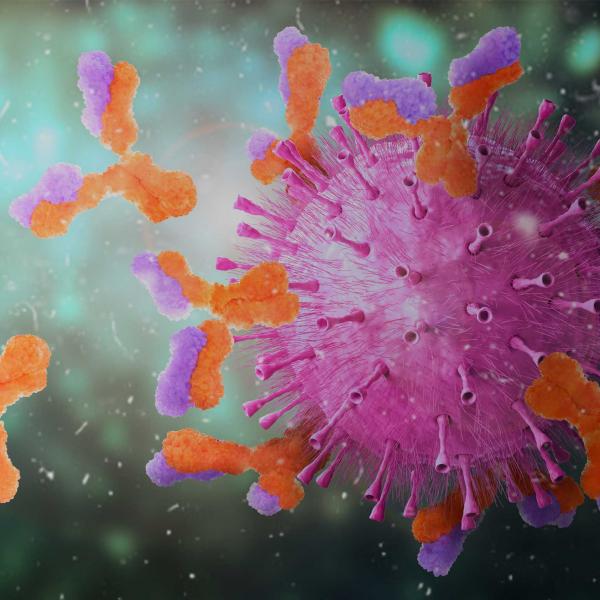Enthusiasm, eagerness, a strong desire toward something. This is the meaning of avidity in conversational English. For biology, avidity is the combined effect of all the interactions that a protein or complex exhibits in a biochemical reaction. It defines an all-encompassing effect. Knowing this we can put into context why AVIDIN is so named.
AVIDIN’s discovery came from the observation of dramatic biotin deficiency (Vitamin H, B7, or Co-enzyme R) in chicks fed a raw egg-white diet1. The conclusion made was that this ‘egg-white injury’ resulted from a component in the egg-white withholding Biotin from the chicks, a finding since repeated in organisms ranging from ants to rats2. It is now known that this component is AVIDIN, which binds biotin in one of the strongest non-covalent bonds identified to date.
AVIDIN is a highly basic glycoprotein tetramer; each molecule an assembly of four identical subunits. Each subunit is composed of 128 amino acids and is capable of binding one biotin molecule. This 1:4 AVIDIN to biotin binding ratio enables a 4-fold amplification of weak biological interactions, a property that has been extensively exploited for research applications.
Making the egg-white a ‘biotin-free zone’
Biotin is essential to life, but rare; synthesised only by plants and a small subset of micro-organisms. All other organisms are reliant on these sources for their continued supply. Despite this natural scarcity, biotin is a key enzyme co-factor critical for cellular metabolic pathways. The egg-white uses this in its favour, employing AVIDIN’s powerful binding of biotin as a core component of its nutritional immune defence system.
Despite comprising only 0.05% of the egg-white, this trace amount of AVIDIN is sufficient to make the egg-white a biotin-free zone. Micro-organisms that make their way past the shell and into the egg-white find themselves entirely starved of this key component for life. Rendered incapable of moving and proliferating, the biotin-withholding property of AVIDIN makes it a potent bacteriostatic. This protective functionality extends to the grown chick, with AVIDIN’s expression being upregulated in several tissues in the chicken upon infection by bacteria or viruses3.
One of the strongest non-covalent bonds in nature
Putting the AVIDIN-biotin binding strength into context is difficult. There are few commonly encountered examples to compare with. One parallel however, which most of us will have had exposure to in the last couple of years, is the binding strength of antibodies.
Antibodies are generated against parts of proteins belonging to biologically foreign bodies. Once an antibody binds to an invading pathogen, the immune system launches a rapid directed response. Most COVID-19 vaccines for example generate antibodies that bind to the spike protein on the outer coat of the virus. This is high affinity binding - a strong interaction between two proteins.
AVIDIN binds to biotin with a strength that is 10,000 to 10,000,000 times stronger4. This is incredible affinity. The AVIDIN-biotin structure formed is resistant to attack by proteolytic enzymes, extremes of temperature, pH, and a range of harsh reagents. For the egg-white this means that once any free Biotin is bound by AVIDIN, it is not released.
Applications of AVIDIN-biotin Technology
The remarkable strength, stability, and efficiency of AVIDIN’s binding of biotin has been used across a range of applications, particularly nanotechnological and biomedical5. The ease of fabrication of biotin-based binders and probes, without affecting the chemical and biological properties of the coupled component makes the system versatile. Trusted and relied upon
for decades, the AVIDIN-biotin system is valued for affinity purification, immuno-assays, diagnostics, non-radioactive labelling, and biochemical assays. The biotin-AVIDIN system enables the study of biorecognition using ligands, fluorescent molecules, and imaging agents, which are all possible to be biotin-coupled with relative ease.
Nucleic acid, Protein, and Peptide delivery
More recently the AVIDIN-biotin system has been used for nucleic acid delivery to overcome the aggregation, short-systemic half-life, and low cellular uptake challenges of delivering siRNAs. The recently reported AVIDIN-nucleic acid nanoassembly (ANANAS) uses a toroidal structure of AVIDINs surrounding a nucleic acid, improving the internalization of nucleic acids at target sites6.
The AVIDIN-biotin system is also used in protein and peptide delivery, which typically requires use of complex encapsulation approaches. AVIDIN shows promise as both peptide delivery carrier, promoting cellular internalisation of peptides. The same stands for vaccine and monoclonal antibody (MAb) delivery. AVIDIN coupling, or fusion proteins ease formulation of delivery carriers and promotes uptake and specificity at target sites. This has been used to deliver peptides across the blood brain barrier using a cross-linked AVIDIN-TfR-MAb strategy7.
AVIDIN remains an irreplicable workhorse in biotechnology with an extensive repertoire of effective use-cases already established. Bioseutica® produces ultra-high purity AVIDIN, making it particularly attractive for maximising the efficacy of probes and derivatives which rely on minimising background. Contact us today to learn more about our first choice AVIDIN.
References
- Eakin R. et al.: Egg-White Injury In Chicks And Its Relationship To A Deficiency Of Vitamin H (Biotin), Science 1940 | Publisher Site
- Poissonnier et al.: Observations of the ‘‘Egg White Injury’’ in Ants. PLOS one. 2014 | Publisher Site
- Kunnas et al.: Induction of chicken avidin and related mRNAs after bacterial Infection, Biochimica et Biophysica Acta. 1993 | Publisher Site
- Diamandis EP & Christopoulos TK.: The biotin(strept)avidin system: principles and applications in biotechnology, Clinical Chemistry 1991 | Publisher Site
- Jain A & Cheng K.: The principles and applications of avidin-based nanoparticles in drug delivery and diagnosis, J Controlled Release 2016 | Publisher Site
- Pignatto et al.: Optimized Avidin Nucleic Acid Nanoassemblies by a Tailored PEGylation Strategy and Their Application as Molecular Amplifiers in Detection, Bioconjugate Chem, 2010 | Publisher Site
- Pardridge WM.: Blood–brain barrier drug delivery of IgG fusion proteins with a transferrin receptor monoclonal antibody, Expert Opinion on Drug Delivery 2015 | Publisher Site




